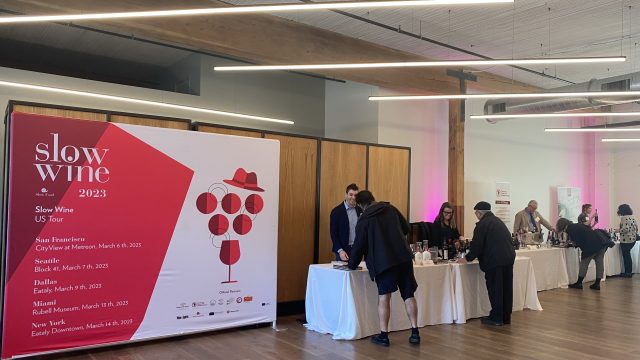Slow Wine USA 2023 returns with a bang
Slow Wine USA’s annual tour returned with a bang to five American cities March 6 – 14 2023. Stops included San Francisco, Seattle, Dallas, Miami, and New York. This year’s event introduced almost 1,500 trade and media to wines listed in the guide.

Selected cities reflect a changing US consumer market. For example, San Francisco replaced Los Angeles due to the former’s proximity to Napa and Sonoma.
Additionally, Seattle replaced Portland about three years ago. “Seattle has been great – and a great surprise for a lot of producers,” said Daniela Porro, senior account executive for Colangelo PR, which represents Slow Wine USA.
“Last year we did Austin, and we’re doing Dallas this year,” she added. “Texas is a huge market. And Miami has been a target city because of the influx of not only Italian people living [there], but post-COVID, so many people from New York have moved to Miami. They also have a huge Latin American community down there, which are big, big spenders and drinkers.”
The US first joined Slow Wine Guide six years ago, and published its first stand-alone version in 2021.“Over the last six years, the Slow Wine Guide USA has evolved to include criteria that wineries must meet to be listed in what is the only annual guide of its kind,” said national editor Deborah Parker Wong via email. Currently, the guide reviews approximately 289 US wineries, and over 2,000 Italian wineries.
Partner Content
Parker Wong and co-editor Pam Strayer, a noted sustainability expert, prove the backbone of the USA guide, overseeing field editors in California, Oregon, Washington, New York. “We list producers who farm without the use of synthetic herbicides, and whose wines are good quality or better,” explained Parker Wong. “Not only do we visit the wineries, but with our farming audit, we do the homework for consumers who want to support wineries that prioritize land stewardship as the foundation of their many sustainable practices.”
Effectively, the Slow Wine Guide USA serves as a greenwashing antidote, recognizing only “fully transparent certifications” such as CCOF (California Certified Organic Farmers), USDA Organic, and Demeter in their audits. It also discusses merits of other methods. “Certification has never been required to be listed in the guide,” stressed Parker Wong, “But in states like Oregon, Washington, and New York, where pesticide use reports are not public record, it certainly makes our job easier.”
The tour also presented seminars on emerging wine regions like Oltrepò Pavese, Asolo Prosecco, and Abruzzo’s Villamagna DOC, plus promising new producers. “For the people that come to our tastings, they can find producers that are family-based, and not so big – under 10,000 cases every year,” said Slow Wine Guide editor-in-chief Giancarlo Gariglio. “These small family-owned wineries also control all steps of production, from farming to bottling to selling. And they are very focused on the terroir – so that you can find your wines very, very close to the place in which they are produced.”
Ultimately, the annual Slow Wine USA tour offers trade and media an easy way to discover terroir-driven, sustainably produced wines listed in the guide. “As we begin our seventh year of research for the 2024 guide,” concluded Parker Wong, “The best way we can support our wineries is for more consumers to use the guide to find them and their delicious wines.”
Link here to purchase a copy of the guide.
Related news
The Castel Group rocked by Succession-style family rift




